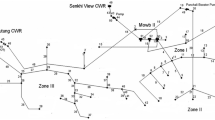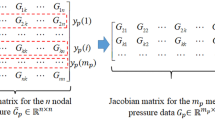Abstract
Water distribution systems with complex configurations are important urban facilities and the hydraulic analysis is essential for system design, optimization and management. Hydraulic analysis involves the procedure of calculating the hydraulic parameters of nodal pressure heads and pipe flow rates under steady-state condition. The equations governing the heads and flows are nonlinear and the most popular method for solving the equations is the Newton-Raphson method, which is the basis of existing hydraulic simulator (EPANET 2). In this paper, fixed point iteration method is proposed for hydraulic analysis after transformation of the original nonlinear equations. Compared to EPANET 2, the proposed method can analyze a water distribution system without differentiation for the convergence for some problems which cannot be solved by EPANET 2. Three test networks were analyzed by the proposed method and EPANET 2. It is proved that the proposed method could get the convergence after a series of iterations, even in cases that EPANET 2 fail. And the initial values of nodal pressure heads and the specified calculation accuracy are considered to have influences on the calculation procedure.






Similar content being viewed by others
References
Abdy Sayyed MAH, Gupta R, Tanyimboh TT (2015) Noniterative application of EPANET for pressure dependent modelling of water distribution systems. Water Resour Manag 29:3227–3242
Abramov NN (1972) Theory and calculation technique for water supply systems. Stroizdat, Moscow
Altman T, Boulos P (1995) Solving flow constrained networks: inverse problem. J Hydraul Eng 121:427–431
Álvarez R, Gorev NB, Kodzhespirova IF, Kovalenko Y, Negrete S, Ramos A, Rivera JJ (2008) Pseudotransient continuation method in extended period simulation of water distribution systems. J Hydraul Eng 134:1473–1479
Álvarez R, Gorev NB, Kodzhespirova IF, Kovalenko Y, Prokhorov E, Ramos A (2011) Pseudotransient continuation-based steady state solver: extension to zero flow rates. J Hydraul Eng 137:393–397
Al-Zahrani MA (2014) Modeling and simulation of water distribution system: a case study. Arab J Sci Eng 39:1621–1636
Bhave PR (1988) Extended period simulation of water systems-direct solution. J Environ Eng 114:1146–1159
Bhave PR (1990) Rules for solvability of pipe networks. J Indian Water Works Assoc 22:7–10
Cross H (1936) Analysis of flow in network of conduits or conductors. University of Illinois Bulletin, Engineering Experiment Station 34(286):11–33
Divenot A (1980) A new method for computation of looped networks. La Houille Blanche 6:365–376
Dokkyun Y, Do-Hyung K, Eunyoun K, Sung-Dae Y (2009) Convergence of a fixed point iteration method for the OSV model. Appl Math Comput 215:1780–1790
Elhay S, Simpson AR (2011) Dealing with zero flows in solving the nonlinear equations for water distribution systems. J Hydraul Eng 137:1216–1224
Giustolisi O, Laucelli D, Colombo AF (2009) Deterministic versus stochastic design of water distribution networks. J Water Resour Plan Manag 135:117–127
Hayuti MH, Burrows R, Naga D (2007) Modelling water distribution systems with deficient pressure. Proc Inst Civil Engineers: Water Manag 160:215–224
He P, Tao T, Xin KL, Li SP, Yan HX (2016) Modelling water distribution systems with deficient pressure: an improved iterative methodology. Water Resour Manag 30:593–606
Islam MS, Sadiq R, Rodriguez MJ, Najjaran H, Francisque A, Hoorfar M (2014) Water distribution system failure: a framework for forensic analysis. Environment Systems and Decisions 34:168–179
Koung HL, George P, Fermín S, Viloche B (2010) Fixed-point iterations in determining a Tikhonov regularization parameter in Kirsch’s factorization method. Appl Math Comput 216:3747–3753
Krope J, Dobersek D, Goricanec D (2006) Flow pressure analysis of pipe networks with linear theory method, proceedings of the WSEAS/IASME Int. Conference on Fluid Mechanics, Miami, Florida, USA, January 18-20:59–62
Liang T (1971) Design conduit system by dynamic programming. J Hydraul Div 97:383–393
Liu J, Yu G (2013) Iterative methodology of pressure-dependent demand based on EPANET for pressure deficient water distribution analysis. J Water Resour Plan Manag 139:34–44
Mariam ASA, Khuri AS (2015) A novel fixed point iteration method for the solution of third order boundary value problems. Appl Math Comput 271:131–141
Rahimi M, Haghighi A (2015) A graph portioning approach for hydraulic analysis-design of looped pipe networks. Water Resour Manag 29:5339–5352
Rossman LA (2002) EPANET 2 User’s manual. Water supply and water resources division. National Risk Management Research Laboratory, Cincinnati
Sarbu I (1987) Computational model of hydraulic state in complex water distribution networks. Hydrotechnics 8:309–314
Sarbu I (2014) Nodal analysis of urban water distribution networks. Water Resour Manag 28:3143–3159
Tabesh M, Shirzad A, Arefkhani V, Mani A (2014) A comparative study between the modified and available demand driven based models for head driven analysis of water distribution networks. Urban Water J 11:221–230
Todini E, Pilati S (1988) A gradient algorithm for the analysis of pipe networks. Wiley, London
Tsakiris G, Spiliotis M (2014) A Newton-Raphson analysis of urban water systems based on nodal head-driven outflow. Eur J Environ Civil Eng 18:882–896
Wood D, Rayes A (1981) Reliability of algorithms for pipe network analyses. J Hydraul Div 107:982–991
Wu ZY, Wang RH, Walski TM, Yang SY, Bowdler D, Baggett CC (2009) Extended global-gradient algorithm for pressure-dependent water distribution analysis. J Water Resour Plan Manag 135:13–22
Yang KP, Liang T, Wu IP (1975) Design of conduit system with diverging branches. J Hydraul Div 101:167–188
Acknowledgements
This study was supported by the National Natural Science Foundation of China (No. 51508452 and No. 51378413), Teaching reform project of Xi’an University of Architecture and Technology (JG021510), Research team on enhanced purification of drinking water and water quality assurance of Xi’an University of Architecture and Technology.
Author information
Authors and Affiliations
Corresponding author
Rights and permissions
About this article
Cite this article
Zhang, H., Cheng, X., Huang, T. et al. Hydraulic Analysis of Water Distribution Systems Based on Fixed Point Iteration Method. Water Resour Manage 31, 1605–1618 (2017). https://doi.org/10.1007/s11269-017-1601-1
Received:
Accepted:
Published:
Issue Date:
DOI: https://doi.org/10.1007/s11269-017-1601-1




